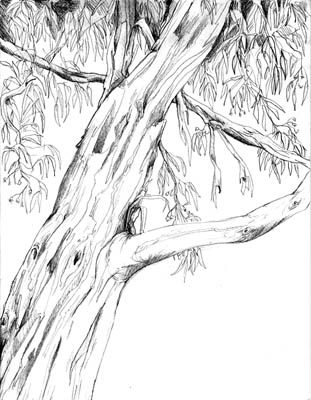Eucalyptus Trees Take Root in California
Australian Immigrant

They have become such a familiar sight in the California landscape that many people probably don’t realize that eucalyptus trees are really transplants from another continent. Almost all of the 600-plus species are native to Australia, where they are the dominant plants in a number of different habitats. There are species that form multi-stemmed shrubs, often called mallees, as well as some of the tallest trees in the world. While a few species have gotten a bad name for their invasiveness here as well as in South Africa, there are many that deserve a place in the landscape.
One character trait that these garden subjects have in common is their extreme drought tolerance. In fact, it is this ability to eke out a living in the bleakest environment that has given some eucalypti a bad name. For years many horticulturists thought that volatile oils or other compounds produced by eucalyptus trees were responsible for the difficulty encountered when trying to grow anything under their canopy. Thorough research by the University of California Extension Service has proved that there are no inhibitory effects from the leaves, roots, or wood. What these scientists have deduced is that eucalyptus root systems are extensive and capable of out-competing many other plants. This is particularly true of a couple of the largest species, Eucalyptus globulus and E. camaldulensis. These two have naturalized in many areas, becoming pests that create fire hazards, drop limbs, and crowd out native vegetation. While they are stately in their own right, their overall size and invasiveness make them unsuitable choices for the urban forest.
There are many more well-behaved species to choose from. Most gardens don’t have room for trees that grow near 100 feet in height, so here are those whose stature is more suited to urban life. Many also have interesting bark, colorful flowers, or decorative seed pods.
Among the smaller species is one that is exploited for its juvenile leaf form. Many eucalypts have two distinct types of leaves; young plants will have round leaves that crowd the length of the stem, while adult plants have long, sickle-shaped leaves. Eucalyptus cinerea is well known in the florist trade for its pleasantly pungent sprays of round leaves covered in a dense white wax. Repeat cutting of the stems is required to keep it in a juvenile state, but it can be kept to fewer than 20 feet to provide an interesting backdrop.
Three species that are grown for their showy flowers and small size are E. erythrocorys, E. kruseana, and E. torquata. The first is known as red cap gum because its flower buds are covered by a bright red cap. This falls off to reveal many bright yellow stamens. The clusters of flowers are showy for many months of the year. E. kruseana also has yellow flowers, but they are scattered along the stem among the foliage. Both can be kept between 10-12 feet with occasional pruning. The third species is called coral gum for its lovely coral red floral pom-poms. It can reach 30 feet, and requires some training to provide strong branches to hold its heavy flowers.
Two other shrubby eucalypts are noted for their interesting seed pods. E. macrocarpa grows only about six feet in height, just perfect for viewing its pink or cream flowers and the three-inch seed pods that resemble flying saucers that follow. The seed pods of E. megacornuta are truly bizarre, though. The lime-green flowers are held in bunches and each seed capsule has a curved, horn-like shape so that the resulting cluster is claw-like. The shrub is rather ungainly, so many plant this one out of sight just to use the flowers and seed pods as cut flowers.
Tree-like eucalypts are sorted according to their type of bark. Among those with thin, flaking bark are some very handsome trees. The lemony scent of the leaves of E. citriodora is delicious underfoot and the pale, peeling trunks are almost sculptural. Trees may grow to 75 feet or more, but have very small heads with few branches. The species with the most ornamental bark is the Mindanao Gum, E. deglupta. The flaking bark reveals many colors, from blue to green, even red or purple. It can grow to 200 feet in its native Indonesia, Philippines, and Papua New Guinea, but may not achieve such heights here. E. melliodora, as its name implies, has a sweet, honey-like fragrance when in bloom. It is a statuesque tree (up to 75 feet) with a slightly weeping habit.
One of the showiest is E. ficifolia, the red-flowering gum. Stout trunks clothed in fibrous bark hold a dense head of leathery leaves, and when it blooms, the whole tree is covered with soft flowers in shades of pink, coral, or red. These are followed by seed pods that look like dice cups. The willowy leaves of E. nicholii have an almost peppermint fragrance and form a graceful crown. The furrowed bark is a rich reddish brown. Another species with thick bark is E. sideroxylon. The nearly black trunks contrast beautifully with the pale blue-green leaves. In bloom, they are complemented by hanging clusters of fluffy flowers in shades of pale pink to red.
This is just a short introduction to this varied genus. There are many more species to choose from. Some of us may wish that the weedy species could be eliminated altogether, but there is no reason not to enjoy their attractive and interesting kin.



